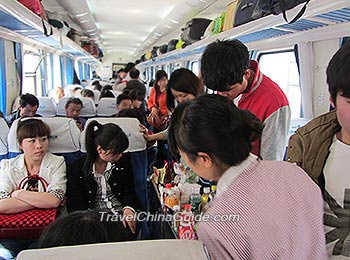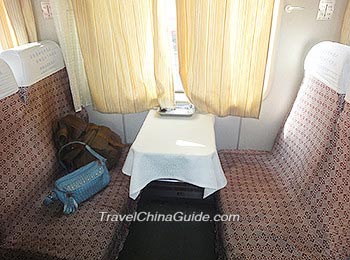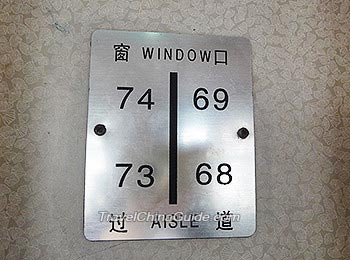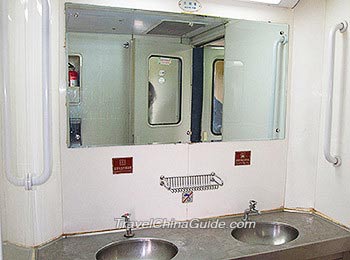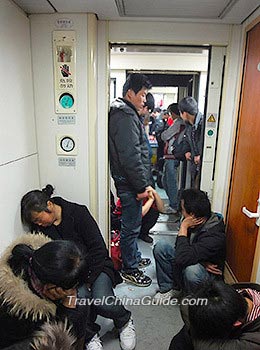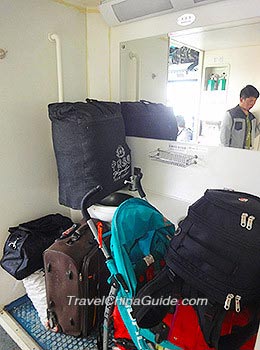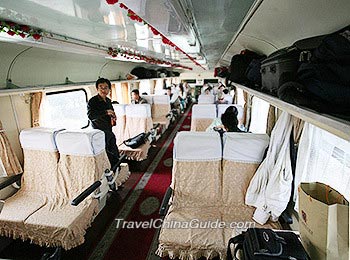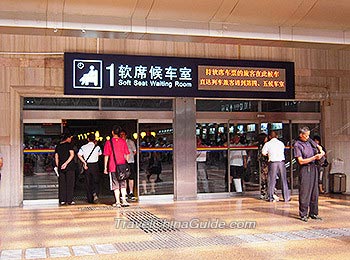Hard Seats & Soft Seats
Hard Seats
A hard seat on China trains only appears on K, T, Z, L and other old type trains. Inside China hard seat train carriage, two rows sit face to face with a small table in between. Each row has 5 seats, a three-seat bench and a two-seat bench on either side of the aisle. The seat back is almost vertical and cannot be adjusted; the seat is only 16 inches (40cm) wide, the smallest among all China train seats, and without any armrest. It is not recommended for a long-distance overnight trip or to foreign passengers, even though China train hard seat ticket price is the cheapest among all.
Luggage racks are above the seats at both sides of the carriage, measuring 20-24 inches (50-60cm) wide and 24-28 inches (60-70cm) high, large enough for big suitcases and backpacks. Passengers can also put their baggage under their seats.
|
|
A hot water heater for drinking water is available at one end of the carriage. It is working when the red light is on, and the water is boiled when the green light is on. Passengers should be careful not to be scalded when using the heater. The toilet is also at the end of each carriage, which are of course squat type and have no toilet paper. Washbasins are both inside and outside of toilet. A dustbin is near to the washing basins outside of the toilet. The connecting area between two carriages is smoking area, where an ashtray is on the wall. Fire extinguishers are also at one end of the carriage.
|
|
A long journey in hard seat carriage is definitely uncomfortable and even unbearable, and is not suggested to foreign visitors, unless you really want to experience a difficult journey in China. An old saying is that 'he who does not reach the Great Wall is not a true man’, but a new one among some foreign visitors is that 'he who does not take a hard seat train trip during the Spring Festival Rush is not a true man’. For the adventurous or maybe just a short daytime journey this is acceptable as it is a wonderful way to experience something of the timelessness of the real China and its people.
|
|
1. Take care of your luggage. If you find any thieves, call for help. There are policemen on the train.
2. Bring some essential medicine with you.
3. Take a bottle and drink hot water rather than cold water.
4. Wear a pair of loose shoes. Sitting for a long period of time and wearing a pair of tight shoes will lead to poor blood circulation, which may cause blood clots in your legs.
5. Carry enough food and snacks.
6. Magazines, newspapers, and playing cards are good to kill time.
7. Pay attention to the food and drinks offered by strangers, a few may be using the offer with an ulterior motive, although this is rare.
8. When the carriage is filled with people and you are wondering how to walk through the aisle to answer the nature’s call, you can follow the food trolley that goes up and down the carriage. People will always make way for the trolley.
Soft Seat
Soft seat on China trains is more comfortable than hard seat. They are only available on a few non-high speed trains in China, including K, T, Y, and S trains. Two rows sit face to face with a table in between. Four soft seats make a row with two at either side of the aisle. Measuring 18 inches (45 cm) wide and with cushion, the seats are roomier and softer. Some seats have armrests and the backs are adjustable. The China train soft seat ticket price is about 1.5 time of that of a hard seat.
|
|
1. The soft seat carriages are quiet and clean, and will not be overloaded - only passengers holding a soft seat ticket are allowed to enter.
2. Some railway stations have special waiting rooms for soft seat passengers, which are clean, quiet and roomy. The seats are sofas rather than plastic and hard chairs in the ordinary waiting rooms. Tea or hot water is also served.
3. Chinese college students get a 50% discount for hard seat, but not for soft seat.
